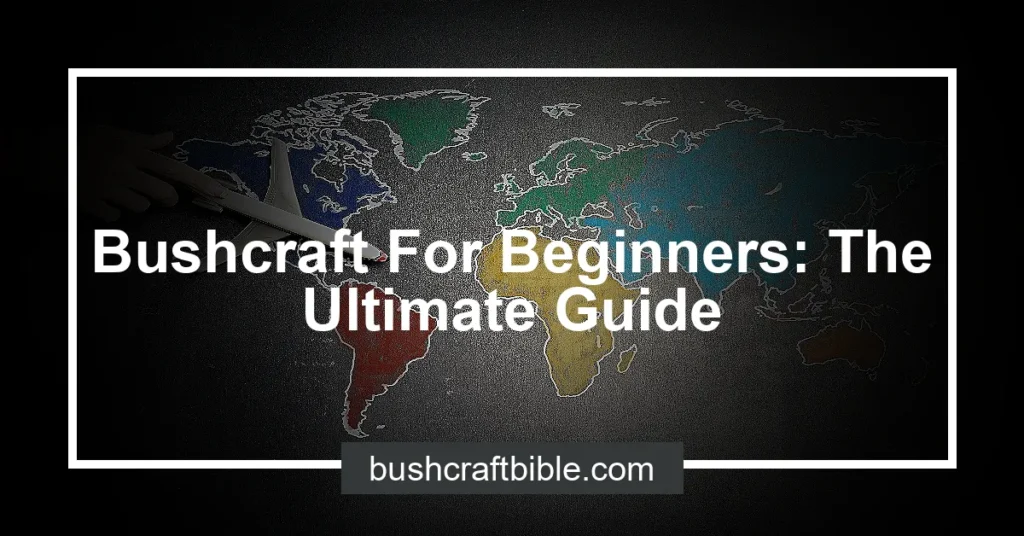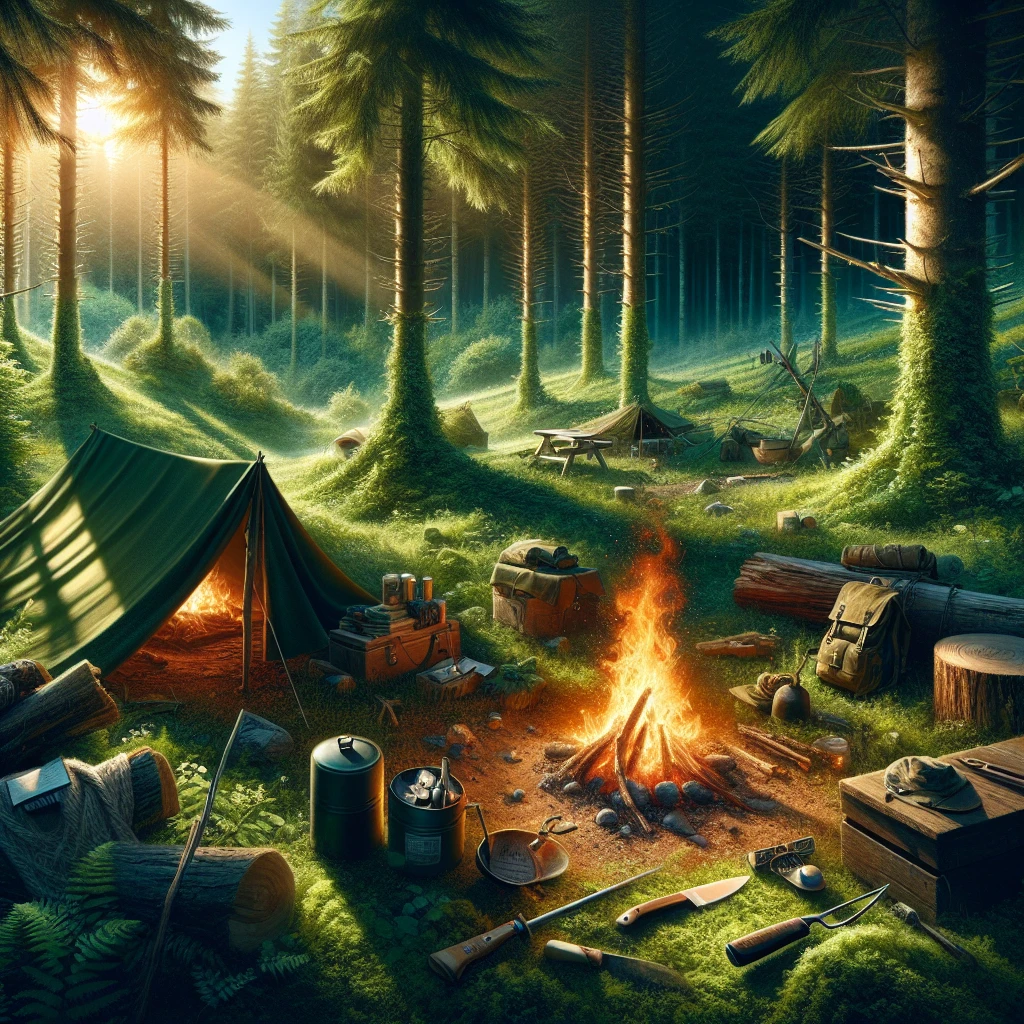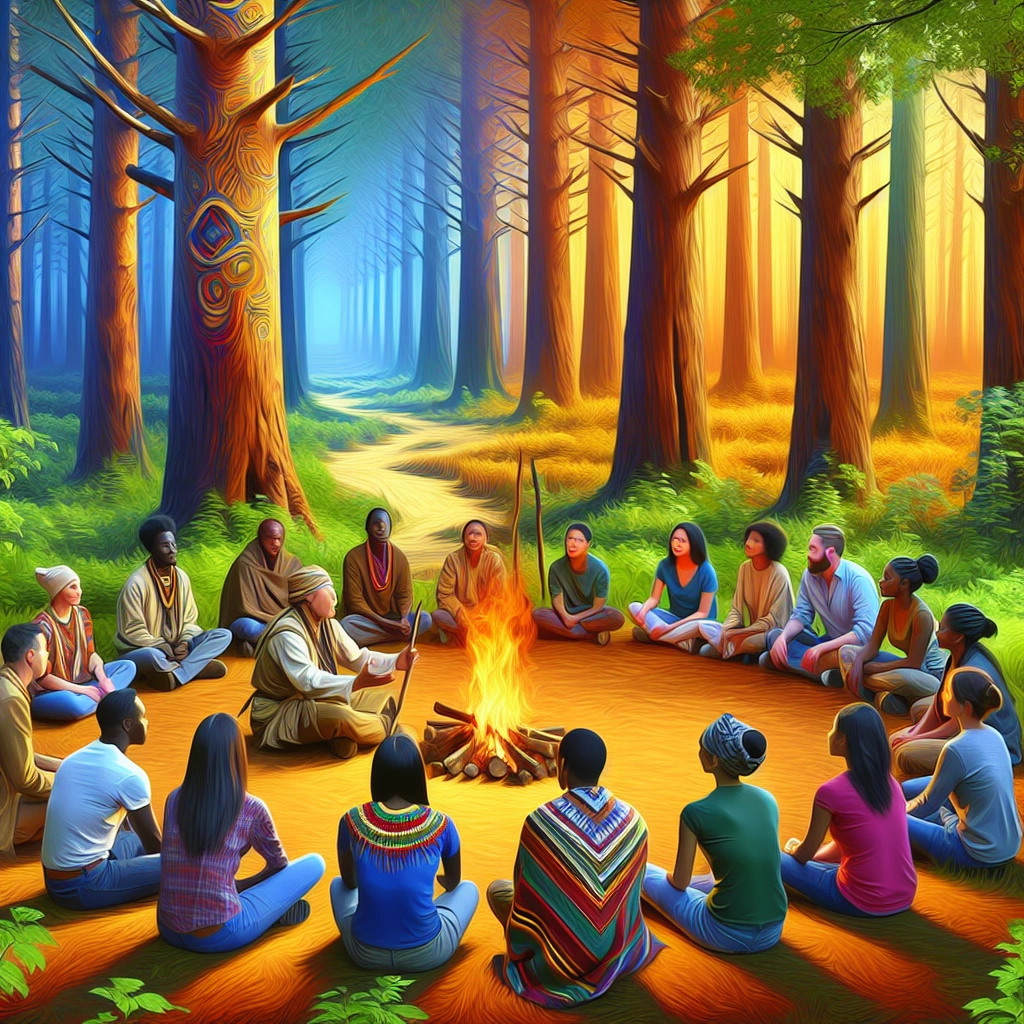

Bushcraft for beginners is a valuable skill set that includes fire making, foraging for food, tracking, trapping, hunting game, and shelter-building using basic bushcraft gear. Learning these skills can help individuals become more independent, confident, and resilient, preparing them for future challenges.
Bushcraft for beginners is important because it teaches valuable life skills such as problem-solving, leadership, teamwork, and communication. These skills can help young people interact with the ecosystem in a meaningful way and become more self-sufficient.
Engaging in bushcraft for beginners can greatly improve physical fitness and provide opportunities to journey, bringing multiple benefits to one’s bushcraft skills, knowledge, experience, and flexibility of application.
Check out this YouTube video: if you want to learn essential bushcraft and survival skills that could potentially save your life in the great outdoors, “Learn 10 Beginner Bushcraft & Survival Skills!” is the perfect place to start.
Bushcraft Skills and Techniques
Shelter Building
Shelter building is a crucial skill for surviving in the wilderness. A lean-to shelter is a simple and effective option, providing rain protection and heat retention when a fire is built in front of it.
For a more advanced shelter, the debris hut offers enhanced insulation. It’s important to know various shelter designs and when to use each type based on the environment and conditions.
Fire Starting Methods
Mastering different fire starting methods is essential for bushcraft survival. Using a flint and steel fire striker or a knife for creating sparks is a handy skill.
Additionally, primitive methods like the hand drill, bow drill, and fire plow are valuable techniques for igniting a fire in the wild. These techniques provide resilience when traditional lighters or matches are unavailable.
Water Sourcing and Purification
Sourcing and purifying water is paramount in bushcraft for beginners. Collecting water with a suitable container or using a makeshift funnel are basic methods.
Boiling is the most efficient way to purify water in the wilderness, ensuring it’s safe to drink. It’s crucial to understand these techniques to prevent dehydration and waterborne illnesses in a survival situation.
Foraging for Food
Foraging for food in the wild is a skill that every beginner should develop. Identifying edible plants, mushrooms, and fruits is essential knowledge.
Additionally, understanding basic trapping and fishing methods can supplement food sources in the wilderness. Learning to distinguish edible from poisonous plants is vital for safe foraging.
Navigation in the Wilderness
Navigating through the wilderness is a foundational bushcraft skill. Learning to use a compass and map, as well as understanding natural indicators like the sun’s position, can help beginners find their way.
Additionally, basic orienteering techniques and understanding local terrain features contribute to safe and effective navigation in the wild.
Tool and Equipment Selection
Selecting the right tools and equipment is critical for bushcraft survival. A reliable knife, fire starter, and shelter building materials are fundamental.
Understanding the proper use of tools like a flint and steel or a hand drill is essential for success in the wilderness. Moreover, choosing lightweight and versatile gear is crucial for efficient mobility and preparedness.
Essential Gear for Bushcraft Beginners
Knife Selection and Care
When it comes to the best bushcraft knife for beginners, the Condor Bushlore knife stands out. Its 110mm (4.3″) full tang blade, crafted from high carbon steel and scandi ground, ensures durability and optimal cutting performance.
As for caring for your knife, regular sharpening with a quality sharpening stone and proper storage in a sheath are essential for maintaining its effectiveness in the wilderness.
Survival Kit Essentials
For survival kit essentials, consider including a reliable water purifier, fire starting tools such as waterproof matches or a ferrocerium rod, a multi-tool for versatility, and a durable tarp for shelter. Additionally, a first aid kit, emergency whistle, and high-energy snacks should not be overlooked in your bushcraft essentials for survival situations.
Clothing and Footwear Considerations
When venturing into bushcraft, clothing and footwear are crucial for comfort and protection. Opt for materials like wool and nylon, steering clear of cotton, especially for garments that directly touch your skin.
Moreover, prioritize wearing warm, comfortable boots or shoes, and consider protective gloves, a hat, and appropriate attire against the sun’s ultraviolet rays, depending on the terrain.
| Terrain Type | Recommended Footwear |
|---|---|
| Smooth Trails | Hiking Shoes or Trail Runners |
| Rocky, Rugged Trails | Supportive Boots |
Remember, preparation is key to conquering the wild, and having the right gear ensures a safe and fulfilling bushcraft experience.
Safety Tips for Bushcraft Beginners
Dealing with Wildlife
When dealing with wildlife in the wilderness, it’s essential to remain calm and signal to the animals that you are human. Being loud and making yourself appear big can help deter potential threats.
Remember, running and turning your back can provoke animals, so it’s crucial to move away slowly to avoid confrontations.
First Aid Basics in the Wilderness
Wilderness first aid basics are critical for bushcraft beginners. Conducting an airway check and examining breathing are vital initial steps.
A well-equipped wilderness first aid kit including disinfectants, bandages, and insect bite ointments is essential for handling medical emergencies in the wild.
Weather and Environmental Hazards to Consider
Understanding weather patterns and environmental hazards is crucial for bushcraft survival. Being prepared for rapid weather changes and having the knowledge to adapt is vital.
It’s important to debunk the myth that a standard kit suffices, as each environment presents unique challenges.
| Safety Tips for Bushcraft Beginners | |
|---|---|
| Dealing with Wildlife | Stay calm, be loud, and move away slowly to avoid confrontations. |
| First Aid Basics in the Wilderness | Conduct airway and breathing checks. A well-equipped first aid kit is essential. |
| Weather and Environmental Hazards | Understanding rapid weather changes and environmental challenges is crucial. |
Finding the Perfect Bushcraft Location
Researching Ideal Wilderness Areas
It’s crucial to research ideal wilderness areas for bushcraft, which are typically large wooded areas with access to water. Places with permission to light fires, hunt, fish, and harvest are ideal for beginners.
Understanding Local Regulations and Permits
Before embarking on a bushcraft adventure, it’s essential to understand local regulations and permits. For instance, in Ontario, non-residents often need a Crown land camping permit to camp on specific territories, as set out by regulations.
Evaluating the Terrain and Natural Resources
Evaluating the terrain and natural resources is vital for a successful bushcraft experience. Understanding the terrain helps in planning shelter and navigation, while identifying natural resources aids in foraging for food and crafting essentials.
Bushcraft for Beginners: Mistakes to Avoid
Overlooking Essential Gear
Mistake: Overlooking essential gear can leave you ill-prepared in the wild. It’s crucial to have a sturdy fixed-blade knife for carving and crafting, along with a reliable, ergonomic handle for comfortable use.
Failing to Plan and Prepare Adequately
Mistake: Failing to plan and prepare adequately leads to potential disaster. Before venturing into the wilderness, ensure you have a clear plan, essential supplies, and knowledge of the area.
Ignoring Basic Safety Protocols
Mistake: Ignoring basic safety protocols poses significant risks. It’s vital to develop habits like pausing, attuning to the surroundings, and following wilderness safety tips to ensure a secure outdoor experience.
The History of Bushcraft and Its Cultural Significance
Origins of Bushcraft Practices
Bushcraft practices have their origins in the traditional skills and knowledge developed by indigenous communities around the world. These skills have been passed down through generations and are rooted in the necessity for survival in natural environments.
From the hunting and foraging techniques of the Aboriginal people in Australia to the shelter-building methods of Native American tribes, bushcraft has evolved as a result of centuries of practical experience and adaptation to the wilderness.
Cultural Traditions and Indigenous Knowledge
The cultural traditions associated with bushcraft are deeply intertwined with indigenous knowledge systems. These practices are not only about survival but also reflect a profound respect for nature and a sustainable way of life.
Indigenous communities have preserved valuable wisdom regarding plant identification, tracking, and resourceful use of natural materials. For instance, the Saami people’s traditional bushcraft techniques in cold climates demonstrate a unique understanding of survival in extreme conditions, showcasing the diverse cultural significance of bushcraft worldwide.
Influential Figures in the Bushcraft Community
Several influential figures have contributed to the popularization and advancement of bushcraft skills. Notable pioneers such as Larry Dean Olsen, Dave Wescott, and Andre Francois Bourbeau have played pivotal roles in promoting the importance of traditional bushcraft knowledge.
Their expertise has been instrumental in shaping modern bushcraft education and emphasizing the value of indigenous wisdom in outdoor pursuits. Additionally, contemporary experts like Ray Mears and Lars Falt continue to inspire and educate enthusiasts, further solidifying the cultural significance of bushcraft in the outdoor community.
| Influential Figures |
|---|
| Larry Dean Olsen |
| Dave Wescott |
| Andre Francois Bourbeau |
| Ray Mears |
| Lars Falt |
Benefits of Learning Bushcraft for Beginners
Building Self-Reliance and Confidence
Learning bushcraft skills fosters self-reliance and confidence as individuals acquire the ability to rely on themselves in challenging outdoor scenarios. Mastering survival techniques empowers beginners to handle adversity and navigate through wilderness environments with assurance.
Connecting with Nature
Engaging in bushcraft activities allows beginners to forge a deeper connection with nature, fostering a profound appreciation for the environment. Through this connection, individuals gain mental tranquility and a sense of harmony with the natural world, promoting overall well-being.
Developing Valuable Survival Skills
Participating in bushcraft equips beginners with essential survival skills, including shelter construction, fire building, foraging, and navigation. These skills are vital for thriving in the wild, ensuring individuals are prepared for unforeseen situations and emergencies, thereby enhancing their ability to overcome challenges in the great outdoors.
Common Myths and Misconceptions About Bushcraft
The Need for Expensive Gear
| Common Misconception | Reality |
|---|---|
| Bushcraft requires expensive gear to be effective. | Actually, bushcraft emphasizes resourcefulness and creativity using minimal equipment. Basic items like a knife, firestarter, and tarp are often sufficient. Expensive gear is not a necessity. |
Wilderness Survival as a Luxury Hobby
| Common Misconception | Reality |
|---|---|
| Some view bushcraft as a luxury hobby for the affluent. | In truth, bushcraft is about connecting with nature and learning essential survival skills. It is not a luxury but a practical, hands-on approach to wilderness living. Anyone can engage in bushcraft regardless of social status. |
Inaccessibility of Bushcraft Skills to Beginners
| Common Misconception | Reality |
|---|---|
| Many believe that bushcraft skills are hard to learn, especially for beginners. | Contrarily, bushcraft is accessible to everyone, including beginners. With the right guidance and commitment, anyone can develop fundamental bushcraft skills such as fire starting, shelter building, and foraging. It’s more about willingness to learn than inherent expertise. |
Training and Courses for Bushcraft Beginners
Finding Reputable Instructors and Programs
Finding reputable instructors and programs can be daunting, but there are a few tried and tested ways to ensure you’re learning from the best. Look for instructors with extensive experience and certifications in bushcraft and survival skills.
Programs affiliated with renowned outdoor organizations or led by experts in the field are often reliable choices. Check for reviews and testimonials from past students to gauge the quality and effectiveness of the training.
Online Resources and Tutorials
Online resources and tutorials are a valuable asset for beginners venturing into bushcraft. Platforms like Bushcraft USA and the Pathfinder School offer comprehensive online courses covering various bushcraft skills.
Additionally, YouTube channels, blogs, and forums dedicated to bushcraft provide a wealth of free tutorials and insights. It’s important to verify the credibility of the sources and prioritize learning from reputable experts in the bushcraft community.
Building a Community of Like-Minded Bushcraft Enthusiasts
Building a community of like-minded bushcraft enthusiasts starts with establishing a shared purpose and fostering a sense of belonging. Engage with fellow enthusiasts through forums, social media groups, and local meetups to exchange knowledge and experiences.
Joining bushcraft organizations and attending events or workshops can also connect you with individuals who share your passion for wilderness survival. Collaborating on projects and sharing learning resources further strengthens the community bond.
Bushcraft Ethics and Leave No Trace Principles
Respecting the Environment and Wildlife
Respecting the environment and wildlife in bushcraft is crucial for preserving the natural ecosystem. It involves minimizing disturbances to the natural habitat and showing consideration for local flora and fauna.
This includes avoiding unnecessary noise, refraining from littering, and respecting wildlife by observing from a distance. By following these practices, beginners can ensure they are respecting the environment and wildlife in their bushcraft pursuits.
Minimizing Your Impact in the Wilderness
Minimizing impact in the wilderness is about treading lightly and leaving no trace of your presence. This involves principles such as avoiding unnecessary damage to vegetation, making minimal campfire impacts, and properly disposing of waste.
Beginners should be mindful of their surroundings, choosing durable surfaces for camping, and disposing of waste in an eco-friendly manner. By adhering to these practices, the impact on the wilderness can be significantly reduced.
Promoting Sustainable Practices in Bushcraft
Promoting sustainable practices in bushcraft entails adopting techniques that prioritize the long-term well-being of the environment. This includes sourcing materials responsibly, conserving natural resources, and supporting sustainable forestry.
Beginners should aim to leave the surroundings better than they found them, respecting the delicate balance of nature. By promoting sustainable practices, beginners contribute to the preservation of the wilderness for future generations to enjoy.
| Respecting the Environment and Wildlife | Minimizing Your Impact in the Wilderness | Promoting Sustainable Practices in Bushcraft |
|---|---|---|
| – Avoid unnecessary noise | – Tread lightly in nature | – Source materials responsibly |
| – Refrain from littering | – Choose durable surfaces for camping | – Conserve natural resources |
| – Respect wildlife from a distance | – Properly dispose of waste | – Support sustainable forestry |
Recommended Amazon Products for Bushcraft for Beginners
Here’s a curated list of products that can help you achieve essential skills and techniques for bushcraft beginner with ease. These recommendations are based on functionality, quality, and customer reviews.
Morakniv Companion Fixed Blade Outdoor Knife


The Morakniv Companion Fixed Blade Outdoor Knife is a highly rated and affordable option for beginners, offering a durable stainless steel blade and a comfortable, high-friction grip handle. It is suitable for various bushcraft tasks, including carving, cutting, and general outdoor use.
| Pros | Cons |
|---|---|
| Affordable | Sheath could be more durable |
| Durable stainless steel blade | Handle may be too small for some users |
| Versatile for different bushcraft tasks |
LifeStraw Personal Water Filter


The LifeStraw Personal Water Filter is a must-have for beginners, providing the ability to safely drink directly from rivers and streams without any additional equipment. This lightweight and compact filter removes bacteria and parasites, making it ideal for wilderness water sourcing.
| Pros | Cons |
|---|---|
| Compact and lightweight | Not suitable for removing chemical contaminants |
| Filters up to 1,000 gallons of contaminated water | Requires a strong suction to use effectively |
| Removes bacteria and parasites |
Ferrocerium Flint Fire Starter


The Ferrocerium Flint Fire Starter is a reliable and long-lasting option for starting fires in bushcraft situations, featuring a durable ferrocerium rod that produces a high-temperature spark. It is a compact, waterproof, and dependable tool for fire starting in any outdoor environment.
| Pros | Cons |
|---|---|
| Durable and long-lasting | Small size can make it easy to misplace |
| Waterproof and weather-resistant | Requires practice to effectively start fires |
| Compact and portable |
TETON Sports Scout 3400 Internal Frame Backpack


The TETON Sports Scout 3400 Internal Frame Backpack is an excellent choice for beginners in bushcraft, offering a comfortable and adjustable fit with plenty of storage space for gear and essentials. With a rugged build and multi-position torso adjustment, this backpack is designed for extended wilderness exploration.
| Pros | Cons |
|---|---|
| Comfortable and adjustable fit | Side mesh pockets are not as durable |
| Rugged and durable construction | Zippers may be prone to snagging |
| Large storage capacity |
Top Recommended Product for Bushcraft for Beginners
If you’re looking for the best solution for essential bushcraft skills and techniques, we highly recommend the Morakniv Companion Fixed Blade Outdoor Knife(https://www.amazon.com/s?k=Morakniv+Companion+Fixed+Blade+Outdoor+Knife). This versatile and affordable knife is perfect for beginners, offering durability, functionality, and high customer satisfaction. Ready to improve your bushcraft skills? Check out the Morakniv Companion Fixed Blade Outdoor Knife today for the best results!


Conclusion
Bushcraft for Beginners is a valuable skill to learn for anyone who enjoys spending time outdoors. The basics of bushcraft, such as fire starting, shelter building, and foraging, are essential for survival in the wilderness.
With the right knowledge and practice, beginners can develop the skills needed to thrive in the natural environment.
Furthermore, learning bushcraft can also foster a deeper connection with nature and a greater sense of self-reliance. By honing these survival skills, beginners can gain confidence and a sense of empowerment, knowing that they can handle unexpected challenges in the wilderness.
The principles of bushcraft can also promote environmental stewardship and a greater appreciation for the outdoors.
Bushcraft for Beginners offers not only practical survival skills, but also a way to connect with nature and develop a sense of resilience. With dedication and hands-on experience, beginners can become proficient in a wide range of bushcraft techniques, making them better prepared for outdoor adventures and potential emergencies.
Frequently Asked Questions
How do you learn bushcraft skills?
I'm trying to learn wilderness survival. Where should I start?
What is the difference between bushcraft and survivalism?
What is the main difference between bushcraft skills and survival skills?
What do Bushcrafters do?
Reference Links
- https://science.howstuffworks.com/life/inside-the-mind/human-brain/survival-psychology.htm
- https://www.noaa.gov/explainers/great-outdoors-weather-safety
- https://www2.gov.bc.ca/assets/gov/farming-natural-resources-and-industry/natural-resource-use/land-water-use/crown-land/land-use-plans-and-objectives/policies-guides/resource_analysis_guide_w_appendices_srmp.pdf










